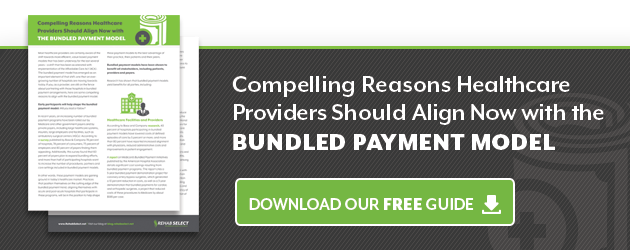 The bundled payment model is a value-based model that compensates healthcare providers for specified episodes of care via an agreed-upon flat rate. A departure from the traditional fee-for-service payment model, bundled payments are designed to reduce healthcare costs and improve quality of care by creating incentives for the establishment of more streamlined and well-coordinated care pathways. Here we'll outline two important ways this payment model improves employee productivity, examining the potential for increased productivity from the healthcare employees providing care under the bundled payment model, as well as employees in other industries receiving that care through employment-based healthcare plans.
The bundled payment model is a value-based model that compensates healthcare providers for specified episodes of care via an agreed-upon flat rate. A departure from the traditional fee-for-service payment model, bundled payments are designed to reduce healthcare costs and improve quality of care by creating incentives for the establishment of more streamlined and well-coordinated care pathways. Here we'll outline two important ways this payment model improves employee productivity, examining the potential for increased productivity from the healthcare employees providing care under the bundled payment model, as well as employees in other industries receiving that care through employment-based healthcare plans.
Addressing the issue of fragmented care
Care fragmentation is widely considered to be one of the more significant issues affecting both the cost and quality of healthcare today, and one that the bundled payment model works to address. Unlike the traditional fee-for-service model, which compensates each provider involved in an episode of care separately, bundled payment plans provide a single payment for all care delivered during that episode, which is then divided between care providers. This typically includes all the procedures, tests, drugs, devices, and services involved in inpatient, outpatient, and rehabilitative care for a patient's medical condition.
What that means for the group of providers is this: cost overruns and/or quality issues by any one provider affects compensation levels for all. That makes close coordination and cooperation between providers essential, creating the incentive for better communication, increased care coordination, and more careful patient monitoring and follow-up.
So just how does all this improve employee productivity? Healthcare employees providing care under bundled care arrangements see significant gains in the efficiency of the care process. This reduces the amount of time they waste on redundant tests, treatments, and office visits, for instance, as well as time spent treating the consequences of inadequate patient monitoring and/or follow-up care.
Employees who receive care under the bundled care model typically benefit from more comprehensive, efficient, patient-centered management of health conditions and/or injuries, leading to faster recoveries and better overall health. Healthier employees miss less time from work and are more productive overall.
Addressing healthcare over-utilization
Another issue that the bundled payment model works to address is healthcare over-utilization, which also significantly impacts the cost and quality of medical care. The fragmentation of care inherent in the traditional fee-for-service model – and the fact that it compensates providers based upon the quantity of care provided to patients – contributes to this problem, promoting redundancy as patients are examined, tested, and treated by various healthcare providers.
Since bundled payment arrangements create powerful incentives to provide tightly-coordinated, high-quality, comprehensive care, inefficiencies in the care process – especially duplication of efforts – are much more likely to be detected and eliminated. Eliminating time-wasting inefficiencies in the care process can improve the productivity of healthcare workers, allowing them to provide more effective care to a greater volume of patients.
It can also work to improve productivity in employees on the receiving end of that treatment. Measures that healthcare providers are taking to discourage costly, time-consuming healthcare over-utilization include more efficient communication and collaboration with partner providers and patients, increased efforts in educating patients about their conditions, and more aggressive follow-up monitoring and care.
Employees who receive this type of patient-centered care tend to be more engaged with and informed about their care, leading to faster, more complete recoveries from illness or injury and less time missed from work. They also benefit from the elimination of redundant medical examinations and testing, which means missing less work time over medical appointments.





